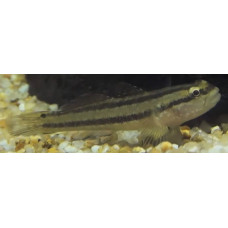Latin name
Tridentiger trigonocephalus
Other names
Tridentiger trigonocephalus
Identification
The body is elongated, relatively low and somewhat compressed at the sides. The cheeks, gill covers and bases of the pectoral fins are bare, without scales. The mouth is small, slightly slanting. The corners of the mouth are below the centre of the eye. The anterior nostrils are short tubes, the posterior nostrils are oval. The upper lip is not protruding at the sides. The lower jaw does not project forward. The head is rather large, the mouth almost horizontal, the lower jaw not projecting forward. The teeth of the anterior, outer row on both jaws are triangular, the central point of each tooth being higher than the lateral ones. The abdominal sucker is rounded, short and does not reach the anus. The caudal peduncle is compressed laterally. Swim bladder present in adults.
Features of fish fins
The upper ray of the pectoral fin is separate from all others. Pectoral fins rounded, their tips may reach the end of the base of the first dorsal fin. Caudal fin rounded.
Fish colouring
The colouration is very variable. There are three main types of body colouration: striped, grey and black. In the striped variety, the body is pinkish or yellowish with an olive tinge, darker on the back. The belly is white, with 2 contrasting dark stripes on the sides, the upper from the eye along the back to the base of the upper rays of the caudal fin, the lower from the beginning of the snout through the eye, the top of the base of the pectoral fins, along the middle of the body to the base of the middle rays of the caudal fin. The fins are transparent. There are 3 black spots on the first rays of the dorsal fin. At the base of the pectoral fins there is a vertical band of pale yellow and crescent shaped. Grey colouration - the body is greyish, pale on the ventral side, with intermittent vertical dark grey stripes. Black colouration - the body is dark, almost black, with imperceptible stripes on the sides. Fins are dark grey. At the base of the pectoral fins there is a bright yellow crescent, and on the second dorsal fin there is a bluish edge. The black variant of the colouration is mainly observed in males guarding the clutch of eggs.
Distribution
Western Pacific: South and East China, the Yellow Sea and the Sea of Japan, the Pacific coasts of Japan and the Philippines.
Habitat
A marine, freshwater, brackish, bottom-dwelling species that prefers temperate climates from 2°C to 20°C. It is a marine ecologically plastic species, tolerating significant salinity gradients. Within its original natural range, the species is common in oceanic saline waters and relatively rare in desalinated brackish waters. In California, it is restricted to the nearshore marine zone and may migrate to estuaries and the lower reaches of rivers. The fish prefers mussel and oyster aggregations, usually on vertical surfaces (collectors, pilings) and less frequently on the bottom, at depths of up to 7-10 metres. They stick to stony, more or less even areas, sometimes with silty, vegetated bottoms, where they find hiding places in the shells of molluscs (oysters, Lepadomorpha, etc.), in crevices between stones and in various algae growths.
Size
Average length 8 cm, maximum up to 11-12 cm. In the Black Sea it reaches a maximum length of 98 mm and a mass of 7.2 g, usually up to 65 mm. Life expectancy up to 3 years.
Behavior
In new habitats, it is an aggressive invasive species that can cause significant damage to native ichthyofauna with high plasticity and the ability to double its population.
Food and feeding habits
The diet is based on crustaceans (Cirripedia, Amphipoda, Ostracoda), polychaetes and fish eggs.
Reproduction
Laying eggs. Eggs are laid in nests guarded by the male. They reach sexual maturity by the end of the first year of life. Spawning takes place in spring and summer at water temperatures of 18-26ºC. The female lays up to 10 portions of eggs per season. The spawning substrate is the inner surface of empty mollusc shells, the surface of rocks or underwater objects. The clutch of eggs is arranged in a single layer. Fecundity of females ranges from 4.8 to 8.6 thousand eggs. Eggs are spindle-shaped, 1.2 to 1.4 mm long. The male aerates and actively guards the clutch. The incubation period is 9-12 days. The larvae and juveniles are pelagic.
Fishing
Nothing is known about Chameleon goby prey or fishing.
Relationship with a person
A species harmless to humans.
| Classification | |
| Phylum | Chordata |
| Class | Actinopterygii |
| Squad | Gobiiformes |
| Family | Oxudercidae |
| Genus | Tridentiger |
| Species | T. trigonocephalus |
| Features | |
| Conservation status | Least Concern |
| Habitat | Bottom |
| Life span, years | 3 |
| Maximum body weight, kg | 0,0072 |
| Maximum length, cm | 12 |
| Sailing speed, m/s | No information |
| Threat to people | Edible |
| Way of eating | Planktonophage |
Chameleon goby
Tags: chameleon goby



